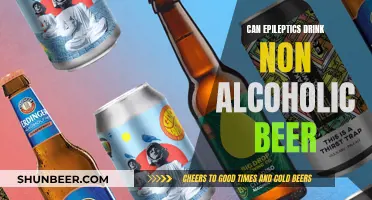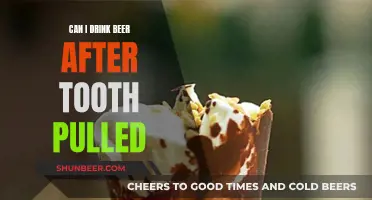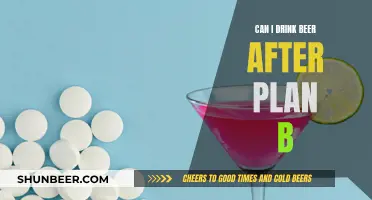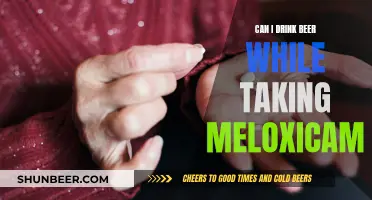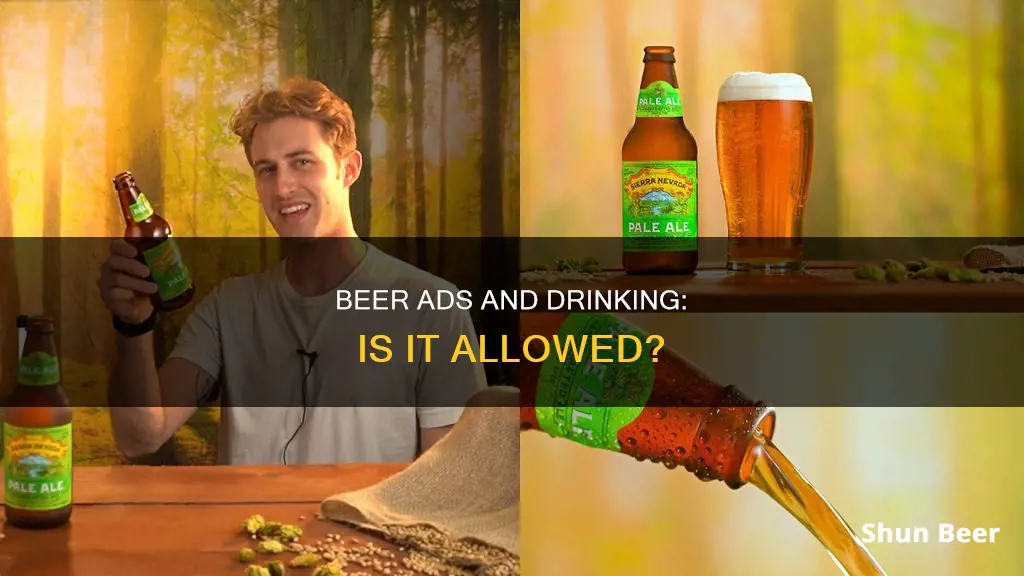
Beer commercials are a staple of advertising, but there is one thing you won't see—someone actually drinking the beer. This curious absence formed the basis of a Heineken ad campaign featuring Neil Patrick Harris, in which he attempts to drink the beer on camera, only to be stopped by the director, who tells him, We can't actually show you drinking Heineken Light on camera. So, what's the reason behind this? Interestingly, it's not due to any federal laws or FCC regulations, but rather a long-standing rule imposed by the TV networks themselves. While the specific reasons for this rule may vary, it appears to be a form of self-regulation by the industry to avoid stirring up controversy and to maintain a conservative approach that doesn't encourage underage drinking.
| Characteristics | Values |
|---|---|
| Who enforces the rule? | Television networks, not the government |
| Is it a law? | No, but it is an effective restriction |
| What is the rule? | You can't show someone drinking beer on camera |
| Where does the rule apply? | Television ads |
| Who does the rule apply to? | Beer companies |
What You'll Learn

Beer ad regulations in the US
Beer advertising in the US is a complex and highly regulated area. While the First Amendment allows for freedom of speech, the marketing and advertising of alcoholic beverages are subject to specific rules. In the US, beer is a widely accepted product with a long history of memorable and distinctive advertising. Brewers use advertising and marketing to inform consumers about their products and foster competition.
In general, advertisements for alcoholic products must be truthful and not deceptive. They must also provide enough information about the product to allow consumers to make educated decisions. While the Tobacco Tax and Trade Bureau (TTB) does not require pre-approval of advertisements, they do offer a voluntary pre-screening service to ensure compliance with regulations.
There are specific requirements for what information must be included in advertisements for malt beverages, wine, and distilled spirits. For malt beverages, the advertiser must include the name, city, state, and contact information, as well as the class to which the product belongs (e.g. ale, stout, lager, etc.).
In addition to these requirements, there are also prohibited practices for alcoholic advertisements. These include making misleading statements, misrepresenting analyses or tests, making false health claims, or targeting minors.
When it comes to drinking beer in a beer ad, there is no specific federal law or FCC rule prohibiting it. However, TV networks have their own long-standing rules and standards regarding the display of alcohol consumption, and brewers are cautious about adhering to these policies to avoid stirring up controversy.
Overall, the beer advertising regulations in the US aim to strike a balance between promoting legal beer consumption among adults while also addressing issues like underage drinking and alcohol dependence.
Drinking 10 Beers: Is It Possible?
You may want to see also

Self-regulation of alcohol marketing
In the United States, the alcohol industry's self-regulatory marketing codes aim to reduce youth exposure to alcohol advertising by minimising underage individuals' access. However, these codes have been criticised for their ineffectiveness, with companies frequently violating the guidelines. For instance, companies have failed to limit alcohol ads to audiences where the percentage of underage individuals did not exceed 30%.
To address these issues, some have suggested implementing comprehensive bans on alcohol advertising or utilising new regulatory approaches that focus on the methods and processes associated with digital media. Others have called for more specific and stringent social media policies regarding alcohol marketing to protect underage users.
Overall, while self-regulation of alcohol marketing aims to curb alcohol marketing activity, evidence suggests that it falls short of effectively protecting vulnerable populations, particularly children and adolescents, from exposure to alcohol advertising.
Beer and Clomid: Safe Mix or Health Risk?
You may want to see also

The Federal Alcohol Administration Act (FAA)
One of the key focuses of the FAA is to protect consumers by ensuring that the labelling and advertising of alcohol beverages provide adequate information about the identity and quality of the product. Alcohol beverage bottlers and importers must obtain a certificate of label approval (COLA) or an exemption certificate before their products can be sold in the United States. The FAA also aims to prevent misleading labelling or advertising that may deceive consumers.
The FAA includes provisions to regulate marketing and promotional practices related to the sale of alcohol beverages. These provisions cover practices such as exclusive outlets, tied house arrangements, commercial bribery, and consignment sales. The Act also addresses unfair trade practices and works to prevent them.
In terms of advertising regulations, the FAA states that it is unlawful for any person engaged in the business of producing, importing, or wholesaling alcohol beverages to publish or disseminate advertisements that are false, misleading, obscene, or indecent. The Act also prohibits statements on labels or in advertisements that disparage a competitor's products. Additionally, advertisements must provide consumers with adequate information about the identity and quality of the product, the alcoholic content, and the person responsible for the advertisement.
The FAA continues to partly remain in force today, providing the legal basis for the powers of the Alcohol and Tobacco Tax and Trade Bureau (TTB). The TTB is responsible for enforcing advertising regulations and ensuring compliance with the FAA's provisions.
Cousin Eddie's Beer Choice: What's His Favorite Brew?
You may want to see also

The Tobacco Tax and Trade Bureau (TTB)
The TTB has various functions, including providing resources for industries it regulates, such as beer, distilled spirits, wine, sake, kombucha, and trade practices. They also offer guidance on advertising regulations for alcohol beverages, including what information is required on advertisements and how to report non-compliant advertising. The TTB's website provides a comprehensive list of regulations and guidance, as well as resources for industry members to understand and comply with federal requirements.
While the TTB does not specifically regulate whether drinking beer is allowed in beer advertisements, it does have standards for the use of terms like "clean" on labels or advertisements. The TTB reviews labels and advertisements in their totality to determine if they create a misleading impression, particularly regarding health-related statements.
It is important to note that the TTB is a federal agency, and its regulations may not cover all aspects of advertising, especially when it comes to self-regulation by television networks or industry groups. For example, while there is no federal law prohibiting the broadcast advertising of alcoholic beverages, television networks may have their own standards and restrictions on the depiction of alcohol consumption in commercials.
Gun Owners and Alcohol: Drinking and Carrying a Firearm
You may want to see also

Alcohol ad restrictions for drinking establishments
Alcohol advertising is a highly regulated industry, particularly when it comes to drinking establishments such as bars and restaurants. While the First Amendment allows for freedom of speech and limits federal government intervention in advertising, alcohol advertisements must be truthful, without deception, and provide enough product information for consumers to make educated decisions.
In the United States, the Federal Alcohol Administration Act (FAA) regulates the marketing and advertising of alcoholic beverages. The Tobacco Tax and Trade Bureau (TTB), hosted by the Department of the Treasury, is responsible for enforcing these regulations. While TTB does not require pre-approval of advertisements, they offer a free voluntary pre-screening service to ensure compliance with the rules.
Drinking establishments often employ various promotions to boost alcohol sales, such as "happy hours," daily drink specials, and "mug clubs." However, state regulations typically govern these practices. For example, daily drink specials are usually limited to one type of alcoholic beverage per day, and happy hours may be restricted to a specific number of hours per day or week. Additionally, all drink promotions must end by midnight, and no alcohol can be discounted between 12:00 a.m. and 2:00 a.m.
Mug clubs are prohibited from offering free drinks as incentives, and establishments cannot use promotions to induce people to purchase alcohol. While small items or giveaways under a certain value may be permitted, free drink promotions and contests that encourage binge drinking or offer drinks as prizes are prohibited.
Furthermore, state regulations may restrict the sale of an unlimited number of drinks to a person or group for a fixed price. Licensees selling alcohol for on-site consumption are also prohibited from serving alcohol to visibly intoxicated individuals, making promotional events subject to state regulations.
To protect underage individuals, alcohol advertisements must not target minors or use images or marketing strategies that intentionally attract younger consumers. Alcoholic beverage companies and the advertising industry have adopted self-regulatory standards to discourage underage drinking, aiming to ensure that at least 70% of the audience for their advertisements is of legal drinking age. Physical advertisements are also placed strategically, avoiding locations near schools, public playgrounds, churches, or areas with high underage foot traffic. Some states mandate a minimum distance of 500 feet between alcohol advertisements and these locations.
These self-imposed regulations also extend to digital media, with alcoholic beverage companies implementing age-verification measures on their websites and marketing communications. Examples include "age gates," registration forms requiring legal drinking age information, and third-party age-verification systems.
While the specific rules may vary across states, drinking establishments must adhere to the regulations governing alcohol advertisements and promotions to ensure compliance and promote responsible drinking practices.
Weed and Beer: Mixing Effects and Experience
You may want to see also
Frequently asked questions
No, you are not allowed to drink beer in a beer ad. Although there is no federal law prohibiting the broadcast advertising of any kind of alcoholic beverage, the TV networks have a long-standing rule against showing people drinking beer on camera.
The rules for drinking in a commercial vary depending on the network and the type of alcohol being advertised. However, in general, advertisements for alcoholic products must be truthful and without deception and provide enough information about the product for the consumer to make an educated decision.
The main reason why you can't drink beer in a beer commercial is to discourage underage drinking and to avoid stirring up calls for new laws restricting alcohol advertising.
There doesn't appear to be a restriction on drinking non-alcoholic beverages in commercials. However, the focus of the commercial and the target audience would be important factors to consider when producing the ad.


